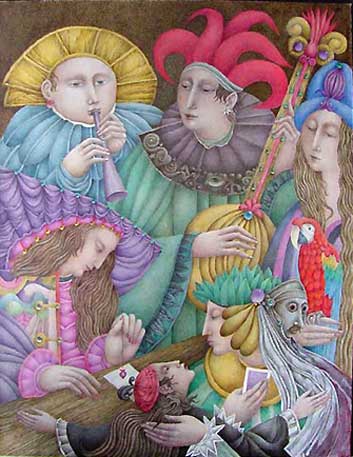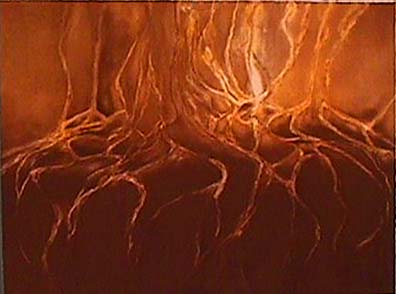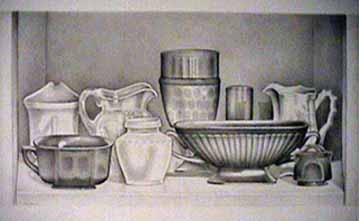 BIDDINGTON'S ART GALLERY--Contemporary Paintings, Sculpture & Prints
BIDDINGTON'S Appraisals & Valuations
BIDDINGTON'S ART GALLERY--Contemporary Paintings, Sculpture & Prints
BIDDINGTON'S Appraisals & Valuations

The Craft of Art
Contemporary Artists and Technical Skill
Helping a friend deposit her sable at its summer spa, I was invited back into the furrier's workroom to watch the making of an intricate coat--one in which contrasting colors of mink were combined to make an overall scrollwork pattern. The cutting, stitching, washing & drying steps created the "fabric" that was then marked, cut, sewn and lined to make a coat. Witnessing just one phase of this process reminded me how much I appreciate skilled craftsmanship and fine, individually-made objects.

In the 20th century, with the ascendance of Dada and its offspring Conceptualism, the art world came to admire a work of art as an idea--with its execution being something of an afterthought. In fact, an artist such as Jeff Koons makes just the design; his works are realized by a fabricating company. And much New Media art exists only as ephemera. Happily, the art world is not monolithic. Many artists have been content to follow their particular visions--some of which involve substantial technical skill to realize. Here are three artists whose work appeals to me as a connoisseur of technique:
Gary Slipper makes his fantasy paintings using a process dating from the Renaissance: First, he lays down ground and gesso layers on a panel or canvas. He then lightly draws the lines of the painting. Then he paints in grisaille (grey-scale) layers defining the lights and darks. Next, comes a series of glazes, applied layer by layer, building the color. This time-consuming process results in an exceptionally luminous--and very durable--artwork. Slipper's paintings bought by collectors in the 60's and 70's remain as subtle, vibrant and structurally sound as those straight from his studio today. Gary Slipper Studio Visit.

Since Gary Slipper paints tightly composed, figurative works, technical ability seems a necessity. Such a skill level may be more surprising in the work of an artist such as Betty Winkler who makes looser, organically abstract artworks. For her prints, Betty Winkler goes through a series of steps to acid etch the first plate so that she can print in exactly the tonal range that she desires. Then, on the second plate, she uses carborundum--an abrasive--which holds the ink such that it produces the velvety, saturated surface that she wants for the work. This results in an intriguing tension between atmospheric and tactile. (So intimately does Winkler understand the tools of printmaking that she visibly cringes when she sees a work realized via the "wrong" technique.) Betty Winkler's Printmaking Notes.

Few artists possess sufficient finesse--and the 20/10 vision--to work in the drawing medium called silverpoint. Silverpoint is literally a piece of silver wire held in a stylus. The trick is to lay down a mark without tearing or piercing the paper. As it passed through the office enroute to a collector, I examined a Laura Shechter still life made in this medium. With the naked eye, I tried to see how she had made the shadings defining the forms in the drawing. Finally, I gave up and resorted to a magnifying glass. Under magnification, I could barely make-out the individual strokes used to build each elegantly rendered form. Laura Shechter's Lecture Notes: Silverpoint and Meticulous Drawing. Laura Shechter Silverpoint Drawing Bottom Shelf
Absent creative vision, these technical achievements would be only that. But these three artists have honed particular skills to further their ideas. In fact, if they were less proficient, their art would suffer. For me, technical expertise adds another layer to the onion; this slowly revealed understanding of the work is the pleasure of art. As an art investor, the complex techniques involved in making the art can only re-inforce its value: such artworks are illusive targets for knock-offs or duplication.
MORE Jake:
PPP Test: Judging Quality in Contemporary Art
Art, Time and Technology
American vs. European Paintings
Jake Biddington's Art as Entertainment
Jake Biddington's Vetted Antiques & Art Shows
Jake Biddington's Patent Numbers as a Dating Tool
Jake Biddington's Hard Assets as Portfolio
Diversification
Jake Biddington's Buying Fine Jewelry at Auction
Jake Biddington's Long Term Investing
Jake Biddington's Short-Term Investing
Jake Biddington's The Craft of Art
Jake Biddington's BENTLEY Art & Travel Series:
Restaurant Guide to Buenos Aires--2006
Tigre, Argentina--Day Trip from Buenos Aires
San Antonio de Areco, Argentina--Weekend Trip from Buenos Aires
Touring Santiago & Valparaiso, Chile
New Haven, Connecticut
Visiting New York City 2006
New York City 2005--Christo's Gates
Montevideo
Buenos Aires--Basic Guide
Amsterdam
Cultural Touring along Spain's Costa del Sol
Touring in Lisbon
Touring in Milan
Touring in Antwerp
Touring in Barcelona
I-80 Park City to New York City
Tourism New York City 2003 Update
Tourism New York City 2002
Hudson, New York (Columbia County)
Tourism Rome 2002 Update
Hartford & Wilton, Connecticut
San Francisco Jackson Square
New Hampshire Route 1A
Morris County, New Jersey
Contact
Jake ABOUT THIS FEATURE
Jake Biddington works on The Street and is responsible for the
opinions & information in INVESTING. Young Jake, as he is known
within the virtual BIDDINGTON clan, views art, antiques and collectibles as
stores of value similar to stocks or foreign currencies. He sees these
items as another type of asset in which to place one's money. To that
end he keeps price histories and charting information on various
categories of objects. He views some items as long term investments,
others as items for a quick trade--and he even sees some as short
sales.
Frankly, Jake's views incite considerable controversy within the
family: His mother, Claire Biddington Rosetti, the curator of
CREATIVE PROCESS, sees Jake's approach as part of the damaging
"commodification" of art wherein the buyers of art comprehend only
its financial value and are blind to its aesthetic and social
significance. Cousin Randolph, (writer of EXPERT CONSULTANCY),
sees the silver lining: For him, the informed expert wins because he
can use his knowledge and judgment to buy superbly interesting--
what Jake would call "off-the-run"-- pieces at relatively cheap prices,
because such items don't fit the narrow criteria for quick
resale.
Once the Bentley is safely garaged and he lounges
sipping his second martini, Uncle Frederick Fieldhouse Biddington
waxes inclusive: "Whatever gives collectors pleasure," he says.
"Whatever amuses."
COPYRIGHT: Images and information within www.biddingtons.com are Copyright Biddington's, Inc.--except where preceded by individual copyrights of the artists.
Downloading or printing for online or print reproduction of any materials without specific written permission from Biddington's, Inc. is prohibited.
PEDIGREE & PROVENANCE--art words & terms defined.
CREATIVE PROCESS--artists' studio visits
BIDDINGTON'S BENTLEY--travel for the art connoisseur. MY ART--Art for kids.







